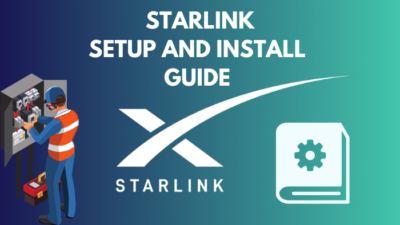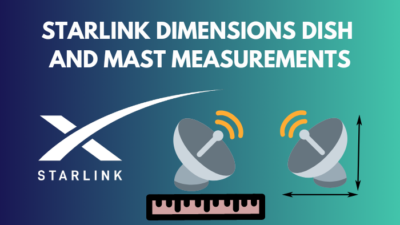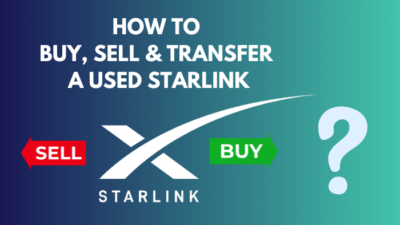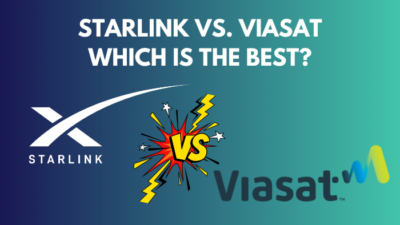Satellite internet helps connect rural and remote areas where broadband internet does not reach.
But satellite internet traditionally had slow speeds and high latency. The expenses were high.
These characteristics made people avail satellite internet only for emergency connection needs.
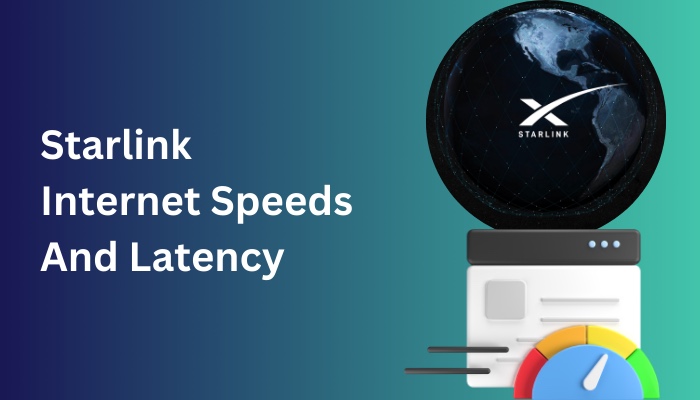
But Starlink, with their low Earth orbit satellites, changed the scenario.
Starlink can deliver high-speed internet with low latency, making it suitable for daily use.
Is Starlink delivering its promised speed and latency? Can you use Starlink in place of broadband internet?
This post will give you a detailed answer to these questions.
After going through the post, you will clearly know if Starlink is suitable in the long run.
You will also know how fast Starlink is compared to broadband internet.
So read the post till the end.
How Fast is Starlink Internet Speed?
Starlink has four different internet plans, and upload speed, download speed and latency slightly vary across the four plans. Per their claims, you can expect 50-200 Mbps download speed, and 10-20 Mbps upload speed in the Starlink residential plan, with a latency of 20-40 ms and no data cap.
Starlink is a satellite internet connection provider. Contrary to broadband internet, which uses cables to reach your house, satellite internet uses satellites in the Earth’s orbit and a dish in your home.
Since the internet data has to reach you through the satellites located up in the sky, satellite internet is slower than broadband internet.
Moreover, typical satellite internet uses geostationary satellites, which move at the same speed as the Earth’s rotation. Then they can cover a fixed region of the Earth, and dishes of the satellite internet users in an area can connect to a single satellite.
But geostationary satellites need to be placed at high altitudes. So the data has to travel a long distance, making satellite internet even slower with high latency.
HughesNet and Viasat are two major satellite internet providers. HughesNet has download speeds up to 25 Mbps, and only 3 Mbps upload speed. Viasat offers up to 100 Mbps download speed, and 3 Mbps upload speed.
As you can see, the satellite internet speeds are pretty low compared to broadband speeds.
On the other hand, Starlink uses low Earth orbit satellites. Low Earth orbit satellites are placed at low altitudes, reducing the signal travel distance. Hence Starlink can achieve as low as 20ms latency.
That’s how Starlink offers better speed than traditional satellite internet connections. In fact, Starlink internet speeds are comparable to broadband internet speeds (and, in some cases, surpass the broadband speed).
Starlink has four internet plans targeting different types of users: residential, RV, maritime and business. Download and upload speed, as well as latency, vary across the four internet plans.
For the Starlink residential plan, the download and upload speeds range between 50-200 Mbps and 10-20 Mbps, respectively. Starlink RV has the same download and upload speeds.
However, there is a catch. During peak hours, when there are a lot of users, Starlink deprioritizes the RV connection. So if the Starlink internet gets saturated in an area, RV plan users will get slower speeds than usual.
Starlink business offers the best speeds out of the four plans (and is also pricier). It delivers download speeds in the range 100-350 Mbps and upload speeds in the 10-40 Mbps range.
The latest Starlink maritime plan offers download speeds and upload speeds of 100-350 Mbps and 20-40 Mbps, respectively.
However, the latency heavily fluctuates in Starlink maritime plan (<90 ms), whereas it is 20-40 ms for the other plans.
There is no data cap for all the Starlink internet plans (but a soft data cap exists in some regions).
You can go to the Starlink website and see the different internet plan details for yourself: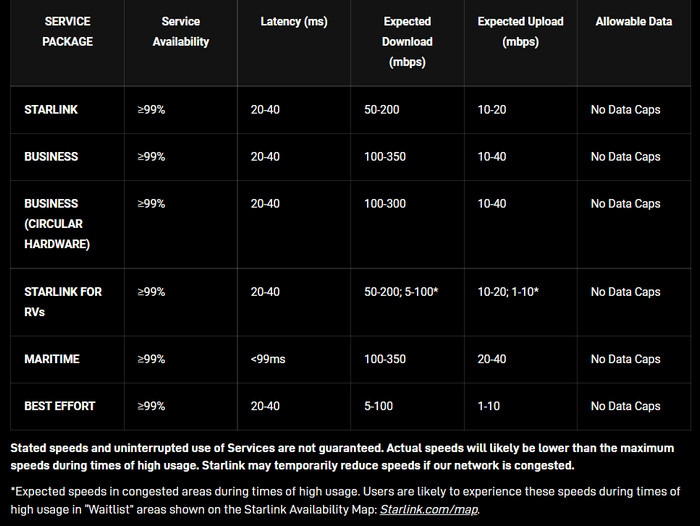
Also, check out our separate post on does Starlink internet have data caps or limits.
How Does Starlink’s Internet Perform In Real Life?
Starlink is the best satellite internet provider right now, with internet speed compared to broadband internet speed. Other satellite internet providers are falling behind by a considerable margin.
According to several online reports, Starlink continues to be the fastest satellite internet connection. The average download speed of Starlink internet is around 100 Mbps, which is within their promised range of 50-350 Mbps (taking into account all the Starlink internet plans).
Other satellite internet providers like HughesNet and Viasat are averaging at about 20-30 Mbps download speed, which is entirely below that of Starlink.
Broadband internet has an average download speed over 100 Mbps and beats Starlink in most cases, as expected. However, there are some regions of the world where Starlink has the fastest download speed, beating broadband connections.
But that does not mean Starlink is the fastest internet connection, as upload speed and latency matter too. Satellite internet connection has low upload speeds compared to broadband internet.
For example, Starlink upload speeds average around 20 Mbps, but it is decreasing over the years. On average, other satellite internet providers offer about 3 Mbps upload speed, which is not good enough for many uploading tasks.
Broadband internet offers the best upload speeds, averaging over 20 Mbps.
As for latency, Starlink is quite close to broadband connections and significantly better than other satellite internet providers. Starlink internet has an average latency of 30-40 ms, as promised on their internet plans.
Latency varies a lot in broadband internet across different ISPs. A decent broadband internet connection has an average latency of 25 ms or less.
But other satellite internet providers like HughesNet and Viasat offer an average latency of around 600 ms, making low latency tasks like gaming impossible.
Remember that Starlink is a satellite internet connection; hence, speeds will vary greatly depending on your location. The figures mentioned above are average figures. So always do some research on the area and ask other Starlink users before considering a Starlink connection.
Also, with more users, Starlink is facing congestion. Many users are reporting online that their Starlink internet service has deteriorated over the years.
As Starlink uses low Earth orbit satellites to serve the internet, capacity depends on the number of satellites available over an area at a given moment. If there are less satellites than required to serve internet to all users in the area, Starlink faces congestion.
The only way to remove congestion is to deploy more satellites. Starlink wishes to deploy around 42000 satellites to cover the whole planet.
But as of now, only 3000 satellites have been deployed, and some are lost due to calamities like a storm. Deploying satellites is quite a lengthy process, so it will take some time for Starlink to reach its goal.
Until then, Starlink tries to control the situation through a waitlist and deprioritizing RV plan users. But that does not seem enough in many regions, as indicated by the complaints of Starlink users.
Some think Starlink will only get worse and become like other satellite internet providers. While it is true that Starlink internet is worse than before, its speed reduction to the likes of HughesNet and Viasat is a long shot.
Starlink took some steps to improve the situation. For example, it has been designing Version 2 of the low Earth orbit satellites which will bring improved speeds and more functionalities (like working with mobile carriers).
But Version 2 of the satellites needs a much more capable rocket to deploy them, and SpaceX has yet to finalize it. If they can make the new rocket and the satellites work, we can hope for better service.
Go and check our other article on Starlink for gaming-is it good or bad.
How Fast Would Starlink Get?
Starlink would get fast and reach the upper limit of their promised speed range if they managed to deploy Version 2 of the satellites and build up the constellation in time. As of now, Starlink is offering a Premium plan with a top download speed of 500 Mbps.
With time, more users are getting a Starlink connection, adding to the existing congestion. While Starlink introduced a waitlist, plans like Starlink RV do not have a waitlist.
So people can skip the waitlist, buy Starlink RV and get into an area already facing severe congestion. It makes the situation more difficult to manage.
And it shows up in various forums and online discussions. Starlink users are facing slower service than before.
So the future success of Starlink depends on the constellation build-up as that is the primary factor holding behind Starlink. If Version 2 of the satellites is deployed successfully, it will bring better speeds.
Also check our exclusive tutorial on can you cancel Starlink internet anytime.
FAQ
Question: Will Starlink be faster than cable?
Answer: Starlink will be faster than cable if they finish up building the constellation of satellites and deploy a better version of them. Even after facing congestion, Starlink’s average speeds are close to that of cable internet.
Question: Is Starlink faster than 5G?
Answer: Starlink is, on average faster than the sub-6GHz 5G. But Starlink is slower than mmWave 5G (which is limited to some areas and faster between the two 5G types).
Question: Is Starlink fast enough for gaming?
Answer: Yes, Starlink is fast enough for gaming. Starlink offers an average download and upload speed of 100 Mbps and 20 Mbps, respectively, with latency in the 30-40 ms range. Latency below 50 ms is decent enough for online gaming.
Question: Will Starlink slow down with more users?
Answer: Starlink has already slowed down with more users due to congestion. Starlink’s capacity depends on the number of available satellites over an area. As people continue to get Starlink connections, congestion increases, resulting in slower speeds.
Final Thoughts
Starlink has a significant impact on the satellite internet industry. Compared to Viasat and HughesNet, Starlink offers a significantly better internet connection.
Starlink internet speeds are comparable to that of broadband internet speeds, which is quite an achievement for satellite internet. Online gaming on satellite internet seemed to be impossible, but not anymore.
Starlink is getting slower daily due to reaching its limit on the number of users. So they need to step up to deploy satellites rapidly
